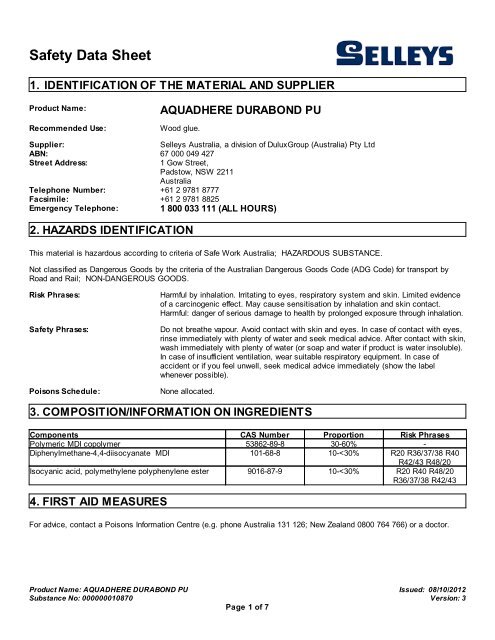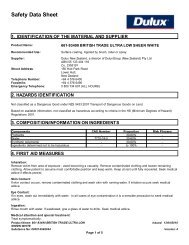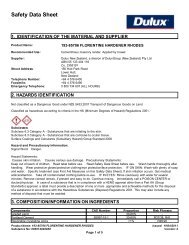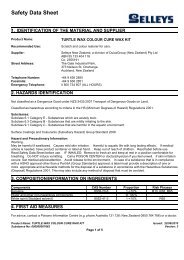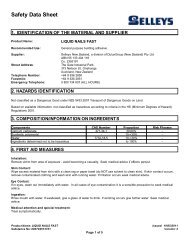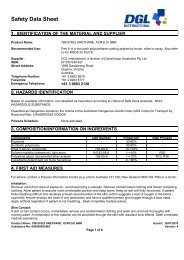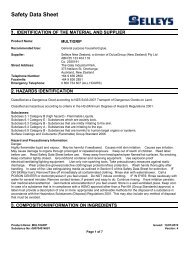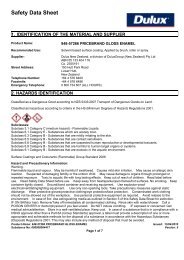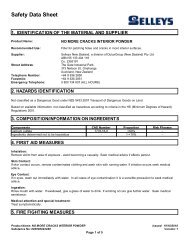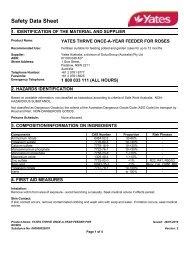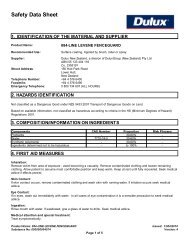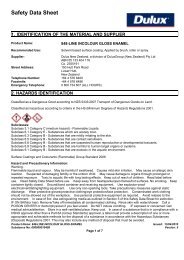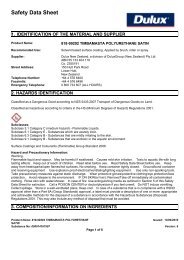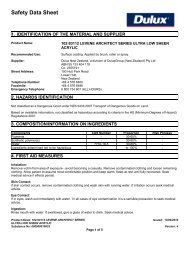Aquadhere Durabond PU - MSDS
Aquadhere Durabond PU - MSDS
Aquadhere Durabond PU - MSDS
Create successful ePaper yourself
Turn your PDF publications into a flip-book with our unique Google optimized e-Paper software.
Safety Data Sheet<br />
1. IDENTIFICATION OF THE MATERIAL AND SUPPLIER<br />
Product Name: AQUADHERE DURABOND <strong>PU</strong><br />
Recommended Use: Wood glue.<br />
Supplier: Selleys Australia, a division of DuluxGroup (Australia) Pty Ltd<br />
ABN: 67 000 049 427<br />
Street Address: 1 Gow Street,<br />
Padstow, NSW 2211<br />
Australia<br />
Telephone Number: +61 2 9781 8777<br />
Facsimile: +61 2 9781 8825<br />
Emergency Telephone: 1 800 033 111 (ALL HOURS)<br />
2. HAZARDS IDENTIFICATION<br />
This material is hazardous according to criteria of Safe Work Australia; HAZARDOUS SUBSTANCE.<br />
Not classified as Dangerous Goods by the criteria of the Australian Dangerous Goods Code (ADG Code) for transport by<br />
Road and Rail; NON-DANGEROUS GOODS.<br />
Risk Phrases: Harmful by inhalation. Irritating to eyes, respiratory system and skin. Limited evidence<br />
of a carcinogenic effect. May cause sensitisation by inhalation and skin contact.<br />
Harmful: danger of serious damage to health by prolonged exposure through inhalation.<br />
Safety Phrases: Do not breathe vapour. Avoid contact with skin and eyes. In case of contact with eyes,<br />
rinse immediately with plenty of water and seek medical advice. After contact with skin,<br />
wash immediately with plenty of water (or soap and water if product is water insoluble).<br />
In case of insufficient ventilation, wear suitable respiratory equipment. In case of<br />
accident or if you feel unwell, seek medical advice immediately (show the label<br />
whenever possible).<br />
Poisons Schedule: None allocated.<br />
3. COMPOSITION/INFORMATION ON INGREDIENTS<br />
Components CAS Number Proportion Risk Phrases<br />
Polymeric MDI copolymer 53862-89-8 30-60% -<br />
Diphenylmethane-4,4-diisocyanate MDI 101-68-8 10-
Safety Data Sheet<br />
Inhalation:<br />
Remove victim from area of exposure - avoid becoming a casualty. Remove contaminated clothing and loosen remaining<br />
clothing. Allow patient to assume most comfortable position and keep warm. Keep at rest until fully recovered. If patient finds<br />
breathing difficult and develops a bluish discolouration of the skin (which suggests a lack of oxygen in the blood - cyanosis),<br />
ensure airways are clear of any obstruction and have a qualified person give oxygen through a face mask. Apply artificial<br />
respiration if patient is not breathing. Seek immediate medical advice.<br />
Skin Contact:<br />
Wipe excess material from skin with a clean rag or paper towel (do NOT use solvent to clean skin). If skin or hair contact<br />
occurs, immediately remove any contaminated clothing and wash skin and hair thoroughly with running water. If swelling,<br />
redness, blistering or irritation occurs seek medical assistance.<br />
Eye Contact:<br />
If in eyes, hold eyelids apart and flush the eye continuously with running water. Continue flushing until advised to stop by a<br />
Poisons Information Centre or a doctor, or for at least 15 minutes.<br />
Ingestion:<br />
Rinse mouth with water. If swallowed, do NOT induce vomiting. Give a glass of water. Seek immediate medical assistance.<br />
Medical attention and special treatment:<br />
Treat symptomatically. Effects may be delayed.<br />
5. FIRE FIGHTING MEASURES<br />
Hazards from combustion products:<br />
Combustible liquid.<br />
Precautions for fire fighters and special protective equipment:<br />
On burning will emit toxic fumes, including those of hydrogen cyanide , oxides of carbon and oxides of nitrogen . Fire fighters<br />
to wear self-contained breathing apparatus and suitable protective clothing if risk of exposure to vapour or products of<br />
combustion.<br />
Suitable Extinguishing Media:<br />
Fine water spray, normal foam, dry agent (carbon dioxide, dry chemical powder).<br />
6. ACCIDENTAL RELEASE MEASURES<br />
Emergency procedures:<br />
If contamination of sewers or waterways has occurred advise local emergency services.<br />
Methods and materials for containment and clean up:<br />
SMALL SPILLS: Avoid skin and eye contact. Wipe up with absorbent (clean rag or paper towels). Allow absorbent to dry<br />
before disposing with normal household garbage.<br />
LARGE SPILLS: Avoid breathing in vapours. Work up wind or increase ventilation. Slippery when spilt. Avoid accidents,<br />
clean up immediately. Wear protective equipment to prevent skin and eye contact and breathing in vapours. Scrape up<br />
excess material before cure. Collect and seal in properly labelled containers. Cured material can only be removed by cutting<br />
or abrasion.<br />
7. HANDLING AND STORAGE<br />
Classified as a C2 (COMBUSTIBLE LIQUID) for the purpose of storage and handling, in accordance with the requirements of<br />
AS 1940. Refer to State Regulations for storage and transport requirements.<br />
Product Name: AQUADHERE DURABOND <strong>PU</strong> Issued: 08/10/2012<br />
Substance No: 000000010870 Version: 3<br />
Page 2 of 7
Safety Data Sheet<br />
Conditions for safe storage:<br />
Store in a cool, dry, well ventilated place and out of direct sunlight. Store away from foodstuffs. Store away from incompatible<br />
materials described in Section 10. Keep dry - reacts with water, may lead to drum rupture. Keep containers closed when not<br />
in use - check regularly for leaks.<br />
Precautions for safe handling:<br />
Keep out of reach of children. Avoid skin and eye contact and breathing in vapour.<br />
8. EXPOSURE CONTROLS/PERSONAL PROTECTION<br />
Occupational Exposure Limits: No value assigned for this specific material by the National Occupational Health and<br />
Safety Commission. However, Exposure Standard(s) for constituent(s):<br />
Isocyanates, all (as -NCO): 8hr TWA = 0.02 mg/m3, 15 min STEL = 0.07 mg/m3, Sen<br />
As published by the National Occupational Health and Safety Commission.<br />
TWA - The time-weighted average airborne concentration over an eight-hour working day, for a five-day working week over an<br />
entire working life.<br />
STEL (Short Term Exposure Limit) - the average airborne concentration over a 15 minute period which should not be<br />
exceeded at any time during a normal eight hour work day. According to current knowledge this concentration should<br />
neither impair the health of, nor cause undue discomfort to, nearly all workers.<br />
`Sen' Notice - sensitiser. The substance can cause a specific immune response in some people. An affected individual<br />
may subsequently react to exposure to minute levels of that substance.<br />
These Exposure Standards are guides to be used in the control of occupational health hazards. All atmospheric<br />
contamination should be kept to as low a level as is workable. These exposure standards should not be used as fine dividing<br />
lines between safe and dangerous concentrations of chemicals. They are not a measure of relative toxicity.<br />
Engineering controls:<br />
Ensure ventilation is adequate and that air concentrations of components are controlled below quoted Exposure Standards.<br />
Use in well ventilated areas. Keep containers closed when not in use.<br />
Personal Protective Equipment:<br />
The selection of PPE is dependant on a detailed risk assessment. The risk assessment should consider the work situation,<br />
the physical form of the chemical, the handling methods, and environmental factors.<br />
Selleys Factory Safe Handling Code: Yellow<br />
MANUFACTURE, PACKAGING AND TRANSPORT: Yellow - Wear overalls (or 'issued' long pants and long sleeve tops),<br />
safety boots, gloves, safety glasses and approved solvent canister. Always wash hands before smoking, eating, drinking or<br />
using the toilet. Wash contaminated clothing and other protective equipment before storage or re-use.<br />
FOR CONSUMER USE: Avoid contact with eyes and skin. Use with adequate ventilation. Rubber gloves and eye protection<br />
are recommended while handling the product.<br />
Product Name: AQUADHERE DURABOND <strong>PU</strong> Issued: 08/10/2012<br />
Substance No: 000000010870 Version: 3<br />
Page 3 of 7
Safety Data Sheet<br />
9. PHYSICAL AND CHEMICAL PROPERTIES<br />
Physical state: Viscous liquid<br />
Colour: Brown<br />
Odour: Slightly Musty<br />
Solubility: Insoluble in water.<br />
Specific Gravity: 1.14<br />
Relative Vapour Density (air=1): Not available<br />
Vapour Pressure (20 °C): 300 (decomposes)<br />
pH: Not applicable<br />
Viscosity: 2350-3350 mPa.s<br />
Evaporation Rate: Not available<br />
10. STABILITY AND REACTIVITY<br />
Chemical stability: Stable under normal ambient and anticipated storage and handling conditions of<br />
temperature and pressure.<br />
Conditions to avoid: Avoid exposure to heat, sources of ignition, and open flame. Avoid exposure to<br />
moisture.<br />
Incompatible materials: Incompatible with acids , alcohols , amines , bases and water .<br />
Hazardous decomposition<br />
products:<br />
Hydrogen cyanide. Isocyanates. Oxides of carbon. Oxides of nitrogen.<br />
Hazardous reactions: Reacts with water liberating carbon dioxide. May rupture closed containers. Reaction<br />
accelerates at higher temperatures. Reaction between water and hot isocyanate may<br />
be vigorous.<br />
11. TOXICOLOGICAL INFORMATION<br />
No adverse health effects expected if the product is handled in accordance with this Safety Data Sheet and the product<br />
label. Symptoms or effects that may arise if the product is mishandled and overexposure occurs are:<br />
Ingestion: Swallowing may result in irritation of the gastrointestinal tract.<br />
Eye contact: An eye irritant.<br />
Skin contact: Contact with skin will result in irritation. A skin sensitiser. Repeated or prolonged skin<br />
contact may lead to allergic contact dermatitis.<br />
Product Name: AQUADHERE DURABOND <strong>PU</strong> Issued: 08/10/2012<br />
Substance No: 000000010870 Version: 3<br />
Page 4 of 7
Safety Data Sheet<br />
Inhalation: Material is irritant to the mucous membranes of the respiratory tract (airways). A<br />
respiratory sensitiser. Can cause possible allergic reactions, producing asthma-like<br />
symptoms. Symtpoms may include irritation of the eyes, nose, throat and lungs,<br />
possibly dryness of the throat, tightness of the chest and difficulty in breathing. Onset<br />
of respiratory symptoms may be delayed for several hours after exposure. A hyperreactive<br />
response may develop to even minimal concentrations of MDI in sensitised<br />
individuals.<br />
Long Term Effects:<br />
No information available for the product. For Isocyanates: Animal studies have shown that respiratory sensitisation can be<br />
induced by skin contact with known respiratory sensitisers including diisocyanates. These results emphasise the need for<br />
protective clothing including gloves to be worn when handling these chemicals or in maintenance work. (1)<br />
There are reports that chronic exposure by inhalation may result in a permanent decrease in lung function. (1)<br />
Toxicological Data: No LD50 data available for the product. For the constituent Polymeric MDI (1):<br />
Oral LD50 (rat): >10000 mg/kg (1)<br />
Dermal LD50 (rabbit): >9400 mg/kg (1)<br />
Inhalation LC50 (rat): 310 mg/m3 (dusts and mists) (1)<br />
12. ECOLOGICAL INFORMATION<br />
Ecotoxicity Avoid contaminating waterways.<br />
Persistence/degradability and<br />
mobility<br />
Not readily biodegradable. (1)<br />
Aquatic toxicity: Based on component data: Low toxicity to aquatic organisms. (1)<br />
24hr EC50 (Daphnia magna) = >1000 mg/L. (1)<br />
96hr LC50 (fish): >1000 mgL (1)<br />
13. DISPOSAL CONSIDERATIONS<br />
Disposal methods:<br />
Refer to Waste Management Authority. Dispose of material through a licensed waste contractor. Empty containers must be<br />
decontaminated.<br />
14. TRANSPORT INFORMATION<br />
Road and Rail Transport<br />
Not classified as Dangerous Goods by the criteria of the Australian Dangerous Goods Code (ADG Code) for transport by<br />
Road and Rail; NON-DANGEROUS GOODS.<br />
Marine Transport<br />
Not classified as Dangerous Goods by the criteria of the International Maritime Dangerous Goods Code (IMDG Code) for<br />
transport by sea; NON-DANGEROUS GOODS.<br />
Air Transport<br />
Not classified as Dangerous Goods by the criteria of the International Air Transport Association (IATA) Dangerous Goods<br />
Regulations for transport by air; NON-DANGEROUS GOODS.<br />
15. REGULATORY INFORMATION<br />
Product Name: AQUADHERE DURABOND <strong>PU</strong> Issued: 08/10/2012<br />
Substance No: 000000010870 Version: 3<br />
Page 5 of 7
Safety Data Sheet<br />
15. REGULATORY INFORMATION<br />
Classification: This material is hazardous according to criteria of Safe Work Australia; HAZARDOUS<br />
SUBSTANCE.<br />
Hazard Category: Xn: Harmful<br />
Xi: Irritant<br />
Risk Phrase(s): R20: Harmful by inhalation.<br />
R36/37/38: Irritating to eyes, respiratory system and skin.<br />
R40: Limited evidence of a carcinogenic effect.<br />
R42/43: May cause sensitisation by inhalation and skin contact.<br />
R48/20: Harmful: danger of serious damage to health by prolonged exposure through<br />
inhalation.<br />
Safety Phrase(s): S23: Do not breathe vapour/mist/aerosol.<br />
S24/25: Avoid contact with skin and eyes.<br />
S26: In case of contact with eyes, rinse immediately with plenty of water and seek<br />
medical advice.<br />
S28: After contact with skin, wash immediately with plenty of soap and water.<br />
S38: In case of insufficient ventilation, wear suitable respiratory equipment.<br />
S45: In case of accident or if you feel unwell, seek medical advice immediately (show<br />
the label whenever possible).<br />
Poisons Schedule: None allocated.<br />
All the constituents of this material are listed on the Australian Inventory of Chemical Substances (AICS).<br />
16. OTHER INFORMATION<br />
(1) Supplier Material Safety Data Sheet; 06/ 2012.<br />
For further copies of this sheet or other product information contact Selleys Customer Service.<br />
Phone: 1300 555 205 (Australia wide)<br />
Fax: 1300 555 305 (Australia wide)<br />
Phone: 0800 735 539 (New Zealand)<br />
Fax: 0800 804 583 (New Zealand)<br />
Reason(s) for Issue:<br />
Revised Primary SDS<br />
Change in Hazardous Substance Classification<br />
Product Name: AQUADHERE DURABOND <strong>PU</strong> Issued: 08/10/2012<br />
Substance No: 000000010870 Version: 3<br />
Page 6 of 7
Safety Data Sheet<br />
This safety data sheet has been prepared by SDS Services.<br />
This SDS summarises to our best knowledge at the date of issue, the chemical health and safety hazards of the material<br />
and general guidance on how to safely handle the material in the workplace. Since DuluxGroup Limited cannot anticipate or<br />
control the conditions under which the product may be used, each user must, prior to usage, assess and control the risks<br />
arising from its use of the material.<br />
If clarification or further information is needed, the user should contact their DuluxGroup representative or DuluxGroup Limited<br />
at the contact details on page 1.<br />
DuluxGroup Limited's responsibility for the material as sold is subject to the terms and conditions of sale, a copy of which is<br />
available upon request.<br />
Product Name: AQUADHERE DURABOND <strong>PU</strong> Issued: 08/10/2012<br />
Substance No: 000000010870 Version: 3<br />
Page 7 of 7


